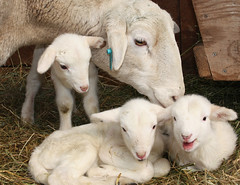The time a lamb takes to bleat after being man-handled has emerged as a novel genetic avenue to boost lamb survival to weaning.
As part of a Sheep CRC study exploring the genetics of lambing, SARDI scientists and colleagues across the country have been delving into the myriad ways to breed for sheep that are more likely to survive well after birth.
 During the lambing season, managers at the CRC’s Information Nucleus sites, including at Struan and Turretfield in South Australia, do two paddock inspection rounds daily, taking crucial measurements of new born lambs within 18 hours of birth, identifying them and their mother.
During the lambing season, managers at the CRC’s Information Nucleus sites, including at Struan and Turretfield in South Australia, do two paddock inspection rounds daily, taking crucial measurements of new born lambs within 18 hours of birth, identifying them and their mother.
One of their final measures involves popping the lambs on the ground and setting the stop watch to time how long it takes them to bleat, and it has revealed some interesting insights.
Studies confirm that of 14 traits investigated soon after birth, ease of lambing, hairier birth coat, shorter time taken for the lamb to bleat, warmer rectal temperature and a shorter crown-rump length (head to butt) showed links to genes for lamb survival.
Read full article at Science Alert
As part of a Sheep CRC study exploring the genetics of lambing, SARDI scientists and colleagues across the country have been delving into the myriad ways to breed for sheep that are more likely to survive well after birth.
 During the lambing season, managers at the CRC’s Information Nucleus sites, including at Struan and Turretfield in South Australia, do two paddock inspection rounds daily, taking crucial measurements of new born lambs within 18 hours of birth, identifying them and their mother.
During the lambing season, managers at the CRC’s Information Nucleus sites, including at Struan and Turretfield in South Australia, do two paddock inspection rounds daily, taking crucial measurements of new born lambs within 18 hours of birth, identifying them and their mother.One of their final measures involves popping the lambs on the ground and setting the stop watch to time how long it takes them to bleat, and it has revealed some interesting insights.
Studies confirm that of 14 traits investigated soon after birth, ease of lambing, hairier birth coat, shorter time taken for the lamb to bleat, warmer rectal temperature and a shorter crown-rump length (head to butt) showed links to genes for lamb survival.
Read full article at Science Alert

No comments:
Post a Comment